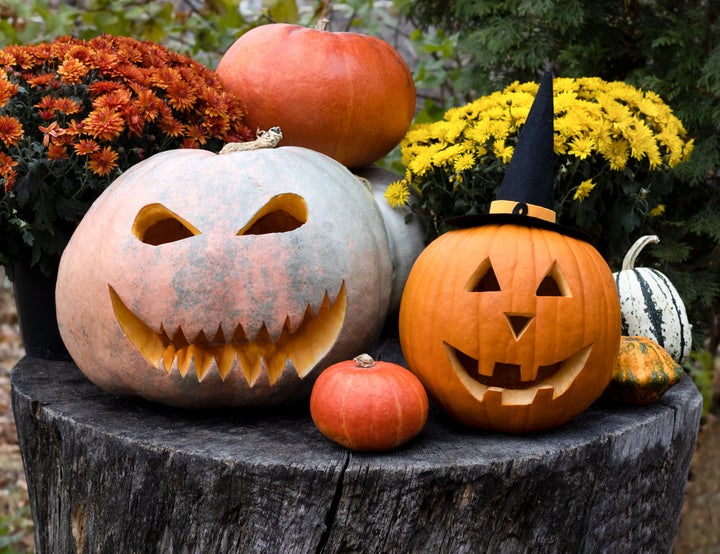
You carve your Halloween pumpkin, put a candle inside, and set it on your front porch before trick-or-treaters arrive. Before anyone knocks on your door, you start thinking about different ways to use this carved pumpkin after the night’s festivities — pumpkin pie, pumpkin bars, pumpkin soup. Can it be a decoration and food?
We spoke to food safety experts about decorative pumpkins and when you can use them as food.
A carved pumpkin shouldn’t ever be eaten for food safety reasons.
“You use a pumpkin as an ingredient or as a decoration, but not as both,” said Darin Detwiler, a professor of food policy at Northeastern University and author of “Food Safety: Past, Present, and Predictions.”
Buying a pumpkin, carving it, having it as a decoration and then turning it into food may seem like a good way to avoid food waste, but food safety should be considered to avoid any risks of food-borne illnesses.
“Pumpkins are a low-acid vegetable, so once they are cut and set at room temperature, pathogens that may be present will grow rapidly on the flesh,” explained Kimberly Baker, a food systems and safety program team director at Clemson University. “The longer the pumpkin is at room temperature, the more pathogens that grow and can make someone sick if they were to eat the pumpkin.”
Once you turn a pumpkin into a jack-o-lantern, it should only be used for decorative purposes for various reasons. We may not follow typical food safety protocols when bringing a pumpkin home. “Often, we are not washing hands before carving, washing the pumpkin, carving them on clean food-safe surfaces or using clean equipment for carving,” Baker said.
A cut or carved pumpkin needs to be kept cold to ensure it doesn’t become a host for bacteria. “Once you cut into it, you must keep it below 40 degrees Fahrenheit to be able to use it [for culinary purposes] later,” said Norman Hunt IV, a chef and certified ServSafe manager at Nicholls State University in Thibodaux, Louisiana.
“Keep in mind that vegetables, including pumpkins, once cut, are considered a TCS — time and temperature controlled for safety — food,” explained Jonathan Deutsch, a food and hospitality management professor at Drexel University in Philadelphia. “That means that it should be cooked immediately or kept refrigerated and cooked within a couple of days for optimal food safety.”
If it’s sitting out for a while, it doesn’t matter if it’s inside or outside.
When a jack-o-lantern is left outside, there is a risk bacteria can grow. “In most of the country, October days can get quite warm, encouraging microbial growth. And critters in urban, suburban and rural environments can all climb in and around jack-o-lanterns,” Deutsch said. “It is not safe or advisable to cook and eat leftover jack-o-lanterns, even if it looks to be in good condition.”
If you’re thinking, I’ll place my jack-o-lantern indoors so there’s no chance of animals and bugs. There’s still a food safety risk. “Keeping a pumpkin indoors does not make a difference for the safety of eating the pumpkin,” Baker explained. “Pathogens can come from any contact surface, inside or outside, and cause the pumpkin to become contaminated.”

Cooking a pumpkin isn’t a solution, either. “Depending on the pathogens, some may not be killed or may leave a toxin behind even if the pumpkin is cooked,” Baker explained.
Want to decorate a pumpkin and eat it later? Do it without carving into it.
Don’t forget that there are other ways to decorate a pumpkin, whether painting it, using stickers, or other creative methods.
“To minimize food waste, one could decorate the pumpkin without cutting it so it can be used as food,” Baker said. “Decorations can be fastened to the outside without puncturing the skin.”
Emilie Berner, a chef-instructor at the Institute of Culinary Education, adds, “I’d recommend they get a smaller pumpkin (less waste) or don’t carve it at all and decorate it creatively with paints, stickers, pom-poms, etc.” If you use paints or glitter, she says, “Make sure to cut all of that away before cooking, and don’t drag it through your pumpkin with your knife as you’re working with it.”
If you change how you decorate your pumpkin this year so you can eat it, rinse it with water before cooking with it to reduce risks of cross-contamination. “Pumpkins are often associated with contaminated soil and irrigation issues due to proximity to animals,” Detwiler said. “Improper cleaning and lack of hand-washing are key factors that place them into the ‘danger category.’”
Carving pumpkins aren’t ideal for eating, anyway.
The truth is most carving pumpkins aren’t the best for eating because they usually don’t have the best flavour or texture, even though they can be consumed.
“These pumpkins have a woody texture, a thin wall, and do not have the full flavor as a pie pumpkin that is bred for use as a food,” Baker said.
Experts recommend choosing smaller pumpkins to roast for pies or to add to soup (sugar pumpkins are a good option). According to Deutsch, “These are usually much fleshier, sweeter and have a smoother texture when cooked.”
Consider saving the seeds and roasting them. “Pumpkin seeds can be roasted and eaten if the seeds are removed at the time of carving and immediately washed and roasted or refrigerated before roasting,” Baker said.
If you decide to carve a jack-o-lantern, reduce waste by tossing it into your compost pile or city compost bin instead of the trash this Halloween. Baker suggested, “Use the carved pumpkin in compost to help fertilize new plants in the spring garden.”
Hunt added, “If you know someone with chickens, [pumpkin] makes a great treat!”